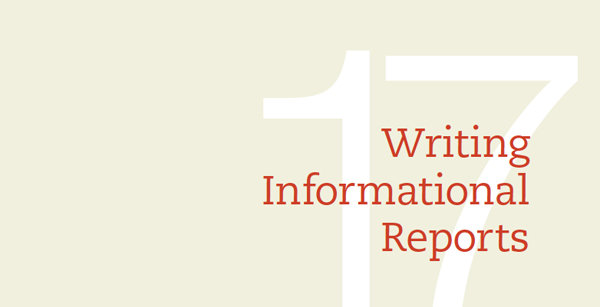17 Writing Informational Reports
Printed Page 445-446

Understanding the Process of Writing Informational Reports
Writing Directives
• DOCUMENT ANALYSIS ACTIVITY: High Plains Water-Level Monitoring Study and 
• DOCUMENT ANALYSIS ACTIVITY: “Global Forest Change” Interactive Map and 
• DOCUMENT ANALYSIS ACTIVITY: Writing a Persuasive Directive
Writing Field Reports
• GUIDELINES: Responding to Readers’ Questions in a Field Report
Writing Progress and Status Reports
• ETHICS NOTE: Reporting Your Progress Honestly
ORGANIZING PROGRESS AND STATUS REPORTS
CONCLUDING PROGRESS AND STATUS REPORTS
• GUIDELINES: Projecting an Appropriate Tone in a Progress or Status Report
Sample Progress Report
Writing Incident Reports
Writing Meeting Minutes
WRITER’S CHECKLIST
EXERCISES
CASE 17: Writing a Directive About Using Agendas for Meetings and 
Complex, expensive projects call for a lot of documents. Before a project begins, a vendor might write a proposal to interest prospective clients in its work. After a project is completed, an organization might write a completion report to document the project or a recommendation report to argue for a future course of action. In between, many people will write various informational reports.
Whether they are presented as memos, emails, reports, or web pages, informational reports share one goal: to describe something that has happened or is happening now. Their main purpose is to provide clear, accurate, specific information to an audience. Sometimes, informational reports also analyze the situation. An analysis is an explanation of why something happened or how it happened. For instance, in an incident report about an accident on the job, the writer might speculate about how and why the accident occurred.
This chapter discusses five kinds of informational reports:
- A supervisor writes a directive explaining a company’s new policy on recycling and describing informational sessions that the company will offer to help employees understand how to implement the policy.
- An insurance adjuster writes a field report presenting the results of his inspection of a building after a storm caused extensive damage.
- A research team writes a progress report explaining what the team has accomplished in the first half of the project, speculating on whether it will finish on time and within budget, and describing how it has responded to unexpected problems.
- A worker at a manufacturing company writes an incident report after a toxic-chemical spill.
- A recording secretary writes a set of meeting minutes that will become the official record of what occurred at a meeting of the management team of a government agency.
Other types of informational reports are recommendation reports (see Chapter 18) and lab reports (see Chapter 19).